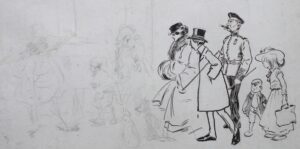May, Phil (1864-1903)
Phil May was born at Wortley, near Leeds, the son of an engineer. His father died when the child was nine years old. His mother was the daughter of Eugene Macarthy, one time manager of the Theatre Royal, Drury Lane. She was left in very poor circumstances and the family had a great struggle to exist. His grandfather, a country gentleman, had some talent as a draughtsman and liked making caricatures. At the age of twelve, in Leeds, Phil became friendly with Fred Fox, whose father was the scenic artist at the recently opened Grand Theatre. This gave him a free run of the theatre, where he used to sketch sections of other people's designs for costumes, as well as sketching actor's portraits for which he received a shilling, later rising to five shillings. Another of his contemporaries was Walter Curtis, who became prominent as a music hall comedian and general entertainer. Soon, Phil May had begun to earn his living in a solicitor's office; before he was fifteen he had acted as time-keeper at a foundry, had tried to become a jockey and had been on the stage at Scarborough and Leeds. He was fond of drawing and when only fourteen years old had drawings accepted for the Yorkshire Gossip. When he was about seventeen he went to London with a sovereign in his pocket. He suffered extreme want, sleeping out in the parks and streets, until he obtained employment as designer to a theatrical costumier. He also drew posters and cartoons, and for about two years worked for the St Stephens Review, until he was advised to go to Australia for his health. During the three years (1886–1889) he spent there he was attached to The Sydney Bulletin, or The Bulletin as it was better known, for which many of his best drawings were made. He produced about 800 drawings for The Bulletin. On his return to Europe he went to Paris by way of Rome, where he worked hard for some time before he appeared in 1892 in London to resume his interrupted connection with the St Stephens Review. His studies of the London guttersnipe and the coster-girl rapidly made him famous. His overflowing sense of fun, his genuine sympathy with his subjects, and his kindly wit were on a par with his artistic ability. It was often said that the extraordinary economy of line which was a characteristic feature of his drawings had been forced upon him by the deficiencies of the printing machines of the Sydney Bulletin. It was in fact the result of a laborious process which involved a number of preliminary sketches, and of a carefully considered system of elimination. His later work included some excellent political portraits. He became a regular member of the staff of Punch in 1896, and in his later years his services were retained exclusively for Punch and The Graphic. He was a founder member in 1898 of the London Sketch Club. He died from tuberculosis in 1903 at his home in St John's Wood, London.
Showing the single result
